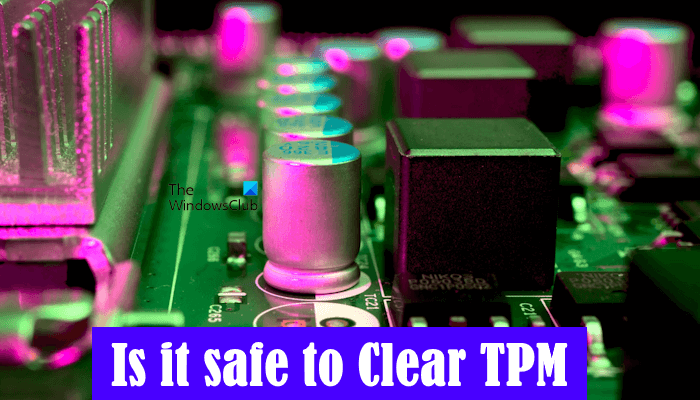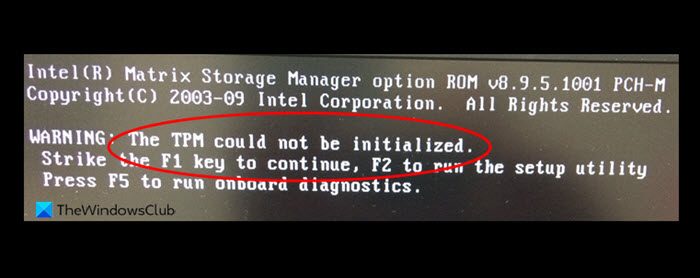TPM stands for Trusted Platform Module. It is a technology designed to provide hardware-based, security-related functions to the supported devices. A TPM is a chip and is one of the required hardware for Windows 11 computers. It is embedded in a computer motherboard and carries out cryptographic operations. Windows 11 has an option to clear TPM. Can we clear TPM? Is it safe to clear TPM when reinstalling or resetting Windows 11? In this article, we will discuss this.

Is it safe to Clear TPM when reinstalling or resetting Windows 11?
You may need to clear the TPM to fix some issues on your computer system, but it should always be the last option. Clearing TPM can result in data loss and other complications. That’s why it is always the last option for Windows 11 users. Moreover, you should also follow some precautions before performing this action. Apart from fixing some issues on your system, you can also clear the TPM before performing the clean installation of Windows 11. But is it safe to clear TPM when reinstalling or resetting Windows 11? Let’s see.
Following are some of the situations when you can clear the TPM:
- When Windows is unable to initialize the TPM
- When you perform a clean installation of a new operating system
- When you are selling your computer
1] When Windows is unable to initialize TPM

Windows automatically initializes TPM. When it fails to do so, you will see the following message:
The TPM could not be initialized.
To fix this error, you can clear the TPM. After this action, the TPM will be restored to its factory default values, and Windows will reinitialize it.
Read next: How to Update and Clear TPM security processor firmware.
2] When you perform a clean installation of a new operating system
If you are performing a clean installation or reinstallation of Windows 11, you can clear TPM.
When it comes to resetting Windows 11, you have two options: resetting without deleting data and resetting by clearing all data. If you are performing a complete reset, you can clear TPM.
Clearing the TPM before performing the clean installation of Windows 11 ensures that the new operating system can fully deploy any TPM-based functionality it includes. Clearing the TPM resets it to an unowned state. After clearing the TPM, the Windows operating system reinitializes it and takes its ownership again.
It is not necessary to clear TPM before performing the clean installation of Windows 11. Most TPM functionality works correctly even if you do not clear it before the clean installation of Windows 11. However, it will be better to clear the TPM.
3] When you are selling your computer
When selling your computer, clearing TPM to the factory default settings is a good step. Clearing TPM will delete all the data and keys stored on the TPM chip. However, if you have encrypted your hard drive with BitLocker, you should decrypt your hard drive and back up all the data before clearing TPM.
Things to take care of before clearing TPM in Windows
There are some precautions that you must follow before clearing the TPM. Have a look at these points:
- When you clear the TPM, all the data stored on the TPM chip will be deleted. This data includes all the keys you created, the BitLocker Recovery key, and data protected by those keys, such as a virtual smart card or a sign-in PIN. Hence, ensure you have a backup of the data recovery method protected by TPM. For example, if you have encrypted your hard drive with BitLocker, note down the BitLocker Recovery Key or you can print it on paper and keep it in a safe place.
- Do not clear the TPM on a device that you do not own, such as your work or school PC.
- If you want to temporarily suspend the TPM operations, it is better to turn off the TPM instead of clearing it. When required, you can turn it on again. Turning off the TPM is not available on TPM version 2.0. If your device has TPM version 1.2, your system may have this option.
- Do not clear the TPM directly from UEFI. Always use the Trusted Platform Module Management Console (tpm.msc) to clear the TPM.
- Before clearing the TPM, you should also read the manual that came along with your computer. You can also contact your computer manufacturer’s support regarding this.
Read: TPM missing or not showing in BIOS
How to turn TPM On or Off
If you have a TPM version 1.2, your computer may have an option to turn on or off the TPM. This option is accessible through the Trusted Platform Module Management Console (tpm.msc). Open the Run command box (Win + R) and type tpm.msc. Hit Enter after that. The Trusted Platform Module Management Console will open. Now, click on the Action menu and see if the option to turn off the TPM is available there. If yes, select it to turn off the TPM. After turning off the TPM, you can turn it on again through the Action menu in the TPM Management Console.
Read: The TPM could not be initialized after BIOS update
Is it safe to install Windows 11 without TPM?
TPM is one of the requirements for Windows 11. If your system does not have the TPM chip, you cannot install Windows 11 on it. However, there are ways to bypass this hardware requirement for Windows 11 installation. Installing Windows 11 without a TPM is not a good idea because of the security threats. TPM protects sensitive data by encrypting it.
What happens if I clear TPM?
Clearing the TPM will clear all the data and keys stored on the TPM chip, including the BitLocker Recovery key. Therefore, back up the BitLocker Recovery Key before performing this action. After this action, the TPM will enter an unowned state. Windows will automatically reinitialize it and take ownership.
Leave a Reply